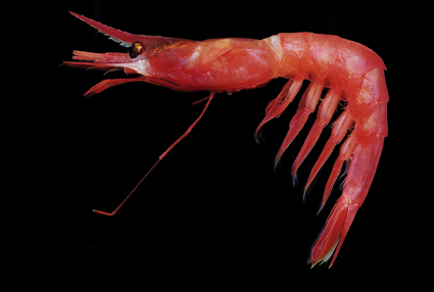Abstract
A recently collected specimen of the rare deep-sea nematocarcinid genus Segonzackomaius Burukovsky, 2011 from the Philippine Basin is new to science and we revealed that the material previously reported as S. altus (Spence Bate, 1888) from Taiwan also belongs to this new species, based on a DNA sequence comparison. The new species S. sursus sp. nov. differs from S. altus by having a relatively shorter but ascending rostrum, and a longer telson, which distinctly exceeds the uropodal endopod. An identification key to the three known species of Segonzackomaius is provided. The multi-gene analyses do not support the monophyly of Nematocarcinus A. Milne-Edwards, 1881 because S. sursus sp. nov. forms a robust clade with N. lanceopes Spence Bate, 1888 and this clade is very separated from other species of Nematocarcinus. Nevertheless, a more extensive molecular study on the phylogenetic relationships amongst the taxa within the family Nematocarcinidae Smith, 1884 is necessary for a better comprehension of its evolution.
References
- Baeza, J.A., Bauer, R.T., Okuno, J. & Thiel, M. (2014) Molecular phylogeny of hinge-beak shrimps (Decapoda: Caridea: Rhynchocinetes and Cinetorhynchus) and allies: a formal test of familiar and generic monophyly using a multilocus phylogeny. Zoological Journal of the Linnean Society, 172, 426–450. https://doi.org/10.1111/zoj.12173
- Bolger, A.M., Lohse, M. & Usadel, B. (2014) Trimmomatic: a flexible trimmer for Illumina sequence data. Bioinformatics, 30, 2114–2120. https://doi.org/10.1093/bioinformatics/btu170
- Burukovsky, R.N. (1991) Shrimps of the family Nematocarcinidae (Decapoda, Caridea) from the western part of the Indian Ocean. Zoologicheskii Zhurnal, 70, 39–46. [in Russian with English summary]
- Burukovsky, R.N. (2000) Taxonomy of shrimps from the genus Nematocarcinus (Crustacea, Decapoda, Nematocarcinidae). 2. Revision of N. longirostris and N. altus, correction of species diagnosis in N. sigmoides and N. lanceopes, and description of new species, N. batei and N. romenskyi. Zoologicheskii Zhurnal, 79, 282–290. [in Russian with English summary]
- Burukovsky, R.N. (2003) Shrimps of the family Nematocarcinidae. Kaliningrad Izdatelistovo KGGU, Kalingrad, 250 pp.
- Burukovsky, R.N. (2005) Systematics of shrimps of the family Nematocarcinidae (Crustacea, Decapoda) from collections of the Berlin Natural History Museum and Senkenberg Museum of Natural History and Research Institute (Germany). Zoologicheskii Zhurnal, 84, 569–579. [in Russian with English summary]
- Burukovsky, R.N. (2011) A new shrimp of the family Nematocarcinidae (Decapoda, Caridea). Zoologicheskij Zhurnal, 90, 1–9. [in Russian with English summary]
- Burukovsky, R.N. (2012) Deep sea shrimps of the family Nematocarcinidae: history of study, systematic, distribution, and biology. Prospekt Nauki, Sankt-Peterburg, 288 pp. [in Russian with English summary]
- Burukovsky, R.N. (2013) Shrimps of the family Nematocarcinidae Smith, 1884 (Crustacea, Decapoda, Caridea) from Taiwan and the Philippines collected by the TAIWAN, PANGLAO 2005 and AURORA expeditions in the western Pacific. In: Ahyong, S.T., Chan, T.-Y., Corbari, L. & Ng, P.K.L. (Eds.), Tropical Deep-Sea Benthos 27. Mémoires du Muséum national d’Histoire naturelle, 204, pp. 155–189.
- Camacho, C., Coulouris, G., Avagyan, V., Ma, N., Papadopoulos, J., Bealer, K. & Madden, T.L. (2009) BLAST+: Architecture and applications. BMC Bioinformatics, 10, 412. https://doi.org/10.1186/1471-2105-10-421
- Chace, F.A. (1986) The caridean shrimps (Crustacea: Decapoda) of the Albatross Philippine Expedition, 1907-1910, Part 4: Families Oplophoridae and Nematocarcinidae. Smithsonian Contributions to Zoology, 432, 1–82. https://doi.org/10.5479/si.00810282.432
- d’Udekem d’Acoz, C.D. & De Grave, S. (2018) A new genus and species of large-bodied caridean shrimp from the Crozet Islands, Southern Ocean (Crustacea, Decapoda, Lipkiidae) with a checklist of Antarctic and sub-Antarctic shrimps. Zootaxa, 4392 (2), 201–240. https://doi.org/10.11646/zootaxa.4392.2.1
- DecaNet Eds. (2025) Nematocarcinidae Smith, 1884. World Register of Marine Species. Available from: https://www.marinespecies.org/aphia.php?p=taxdetails&id=106784 (accessed 24 January 2025)
- Komai, T. & Aungtonya, C. (2024) Notes on two species of the deep-sea shrimp genus Nematocarcinus A. Milne-Edwards, 1881 (Decapoda: Caridea: Nematocarcinidae) collected by the Thai-Danish BIOSHELF surveys (1996–2000) from the Andaman Sea, off southwestern Thailand. Phuket Marine Biological Centre Research Bulletin, 81, 105–115.
- Komai, T. & Segonzac, M. (2005) Two new species of Nematocarcinus A. Milne-Edwards, 1881 (Crustacea, Decapoda, Caridea, Nematocarcinidae) from hydrothermal vents on the North and South East Pacific Rise. Zoosystema, 27, 343–364.
- Li, D.H., Liu, C.M., Luo, R.B., Sadakane, K. & Lam, T.W. (2015) MEGAHIT: an ultra-fast single-node solution for large and complex metagenomics assembly via succinct de Bruijn graph. Bioinformatics, 31, 1674–1676. https://doi.org/10.1093/bioinformatics/btv033
- Macpherson, E. (1984) Crustáceos Decápodos del Banco Valdivia (Atlántico sudoriental). Resultados Expediciones Científicas, 12, 39–105.
- Matzen da Silva, J., Creer, S., dos Santos, A., Costa, A.C., Cunha, M.R., Costa, F.O. & Carvalho, G.R. (2011) Systematic and Evolutionary Insights Derived from mtDNA COI Barcode Diversity in the Decapoda (Crustacea: Malacostraca). PLoS One, 6, e19449. https://doi.org/10.1371/journal.pone.0019449
- Pequegnat, L.H. (1970) Deep-sea caridean shrimps with descriptions of six new species. In: Pequegnat, W.E. & Chace, F.A. (Eds.), Texas A&M University Oceanographic Studies. Vol. 1. Contributions on the biology of the Gulf of Mexico, pp. 59–123.
- Poore, G.C.B. & Ahyong, S.T. (2023) Marine Decapod Crustacea. A Guide to Families and Genera of the World. CSIRO Publishing, Melbourne and CRC Press, Boca Raton, Florida, 928 pp. https://doi.org/10.1071/9781486311798
- Poore, G.C.B. & Kou, Q. (2024) Paratrypaea Komai & Tachikawa, 2008 (Decapoda: Axiidea: Callianassidae): more than two or three species. Journal of Crustacean Biology, 44, ruae015. https://doi.org/10.1093/jcbiol/ruae015
- Rose, R., Golosova, O., Sukhomlinov, D., Tiunov, A. & Prosperi, M. (2018) Flexible design of multiple metagenomics classification pipelines with UGENE. Bioinformatics, 35, 1963–1965. https://doi.org/10.1093/bioinformatics/bty901
- Spence Bate, C.S. (1888) Report on the Crustacea Macrura collected by the H.M.S. Challenger during the years 1873–76. Report on the scientific results of the voyage of H.M.S. Challenger during the years 1873–76. Johnson Reprint Corporation, New York, New York, 942 pp.


